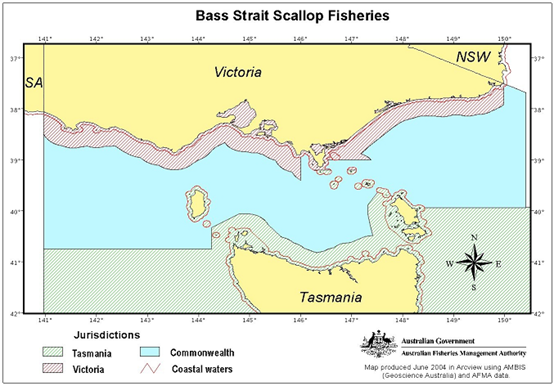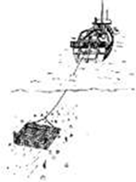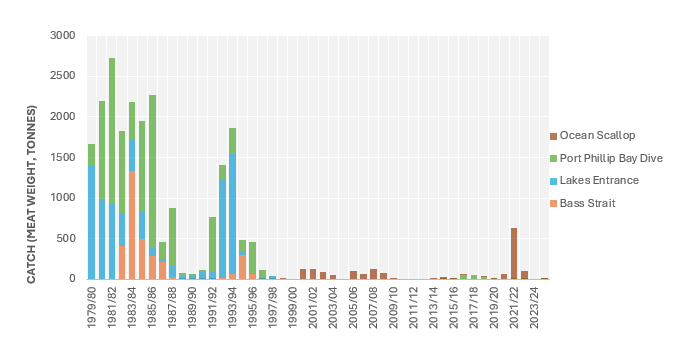Scallop Fishery
Commercial fishing for scallops has been part of the Victorian fishing industry since the early 1970's. In 1986, management of the Bass Strait Scallop Fishery was split between the Commonwealth, Tasmania and Victoria under an Offshore Constitutional Settlement (OCS). Through the OCS, three zones emerged: the Commonwealth central zone, a Victorian zone and a Tasmanian zone.
The waters of the Victorian zone extend out to 20 nautical miles from the high tide water mark, but exclude the bays and inlets along the coast where commercial fishing for scallops is prohibited.
The fishery is characterised by highly variable catches due to severe fluctuations in the resource. In some years, there are so few scallops that fishing cannot take place as it would put undue pressure on stocks and threaten the long-term survival of the stock and fishery.
Fishery Overview details the Victorian Scallop Fishery, including species information, fishery location, fishing method, management arrangements and fishery statistics.
The total allowable commercial catch details the process and methods used for setting the annual quotas.
Fishery Overview
- Summary – Key Elements of the Scallop Fishery
- The Species
- The Fishery
- The Fishing Method
- Management Arrangements
- Fishery Statistics and Data
Summary – Key Elements of the Scallop Fishery
Scallop Fishery | |
Species | Pecten fumatas |
Fishery boundary | The fishery extends the entire length of the Victorian coastline and out to 20 nautical miles from the shoreline |
Fishing method | Scallop dredge |
Primary management method | Quota – individual transferrable quota units and total allowable catch |
Secondary management methods | Legal minimum length, gear restrictions, vessel monitoring systems on all boats |
Maximum number of licences | 88 |
Legal minimum length | 80mm (at the widest part of the shell) |
The Species
The Victorian Scallop Fishery is based on the species, Pecten Fumatus. Occasionally, incidental catches of doughboy scallops (Chlamys asperrimus) are taken as by-product, but are generally not in commercial quantities.
Scallops mature after one year but do not spawn until the second year. Adult scallops normally spawn between late winter and early spring.
Larval scallops drift as plankton for up to six weeks before first settlement. They attach to a hard surface such as seaweed or mussel and oyster shells and remain attached until reaching around 6mm in length. The small scallops then detach themselves and settle into sediments and bury in so that only the top flat shell is visible. The juvenile scallops grow quickly and reach marketable size within 18 months.
The Fishery
The Victorian Scallop Fishery is one of three scallop zones in the Bass Strait, and extends out from the coastline to 20 nautical miles. The same arrangement is in place in Tasmania and the area of water between the two state zones is managed by the Commonwealth Government (see Figure 1, courtesy of the Australian Fisheries Management Authority). The current boundaries were settled in 1986 with an Offshore Constitutional Settlement agreed between the three jurisdictions.

Historically, the majority of the fishing activity in the Victorian zone has occurred in the eastern waters of the State, with most vessels launching from the ports of Lakes Entrance and Welshpool.
A commercial scallop fishery also operated in Port Phillip Bay until 1997 when it was closed to commercial operators. The area has remained accessible to recreational fishers.
The Fishing Method

Commercial fishing for scallops is by dredging; vessels tow a single dredge that is dragged along the seabed. Dredges are deployed from the rear of the vessel and are up to 4.5 metres wide. A tooth-bar on the bottom of the mouth of the dredge lifts scallops from the seafloor and into the dredge baskets.
Management Arrangements
To participate in the Scallop Fishery, fishers must possess a Victorian Scallop (Ocean) Fishery Access Licence. The number of licences has been capped at 91, and approximately 10-15 boats operate in the fishery. The majority of active operators in this fishery also possess entitlements to fish in Commonwealth waters.
The fishery is primarily an output-controlled fishery that has been managed under Individual Transferrable Quota (ITQ) arrangements since 1998. Quota is set annually and is transferable between licence holders on a permanent or temporary basis.
The fishery is open continuously throughout the year, with the most recent fishing season commencing on 1 April.
A number of input controls are also used in the fishery:
- Minimum size: currently, scallops taken must be more than 80mm wide when measured in a straight line at the widest point across the shell.
- Discard rate: to protect juvenile stock, fishing areas can be closed if more than 20% of the scallops in the catch are below the minimum size limit. Under a Code of Practice developed by commercial fishers and The Victorian Fisheries Authority, when juvenile beds of scallops are identified, GPS coordinates are used to establish spatial zones that are not fished.
- Meat per kilogram: also under the Code of Practice is a further management control designed to ensure the quality of the product and to enhance commercial returns; if the average number of individual scallop meats (adductor muscle) is more than 100 per kilogram, the fishery can be closed until the quality of the scallops improves.
In response to falling catch rates, the stock abundance in the fishery was surveyed in 2009 and 2012. Both surveys revealed very low densities of scallops throughout the traditionally fished areas of the fishery. Consequently, no quota was made available between 2010 and 2013.
Following this period, during years of low abundance, a small amount of quota has been allocated to licences, totalling 1.5t per licence. This allows for controlled exploratory fishing to take place to determine if there has been any recovery in the stocks.
Fishery Statistics and Data
Scallop abundance is naturally highly variable causing catches to fluctuate widely from season to season. Since the beginning of the commercial fishery in the 1970's, catches have varied from tens of tonnes to thousands of tonnes (Figure 2). Catch rates, and therefore stock abundance, declined in the mid- to late 2000's, and surveys of scallop grounds conducted in 2009 and 2012, revealed a lack of commercial quantities of scallops. In response, quotas of zero were put in place for the 2010/11, 2011/12 and 2012/13 seasons.
Surveys following this period revealed an indication of stronger recruitment of juvenile scallops. In response, a conservative TACC of 136.5 t, or 1.5 t per licence, was set for the 2013/14 and 2014/15 seasons. Between the period of 2015/16 to 2020/21 the TACC was set at 135 t, reflective of the reduction in total licences.
In 2020, anecdotal reports suggested commercially viable scallop beds existed in areas of the Tarwhine oil and gas field. In response, pre-season surveys commenced based on techniques used in the Tasmanian and Commonwealth scallop fisheries. Results identified significant recruitment in the fishery and the return of viable scallop beds in Victoria. Under the guiding management arrangements in place for the fishery, the total TACC was increased to 979 t. This equated to approximately 12% of available biomass, and was maintaned through the 2022/23 season.
The 2023/24 Pre-Season Survey identified a significant reduction in these viable scallop beds. In response, and following the harvest strategy, the TACC returned to a baseline level, totalling 132 t.
The trend in total catches across all scallop fisheries is outlined in Figure 2.

Figure 1: Time series of catch (meat weight, tonnes) in the Victorian Scallop Fishery. Port Phillip Bay was closed to commercial fishing in 1997, and in 1998 the licences for Bass strait and Lakes Entrance were combined to be called 'Ocean Scallop'.
Total Allowable Commercial Catch
When open, the fishery is managed using a quota management system of individual transferable quota. Annual consultation is undertaken to determine the total allowable commercial catch (TACC) and is based on a combination of stock survey analysis and scientific and industry expertise.
After consultation, Victorian Fisheries Authority, on behalf of the Minister for Outdoor Recreation, then sets the TACC via a Further Quota Order and distributes the quota equally amongst the licences.
